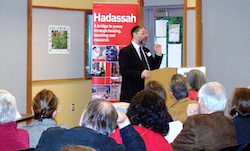By Janis Siegel, JTNews Correspondent
She was groggy and admittedly still under the effects of the anesthesia in May 2004, when doctors at Mt. Sinai Hospital in New York told Katie Edelstein, a Hadassah national executive board member, that that her “extra” kidney was accepted by the transplant recipient. As she recalled the story at an April fundraiser of the Seattle Chapter Hadassah to raise money for its hospitals in Israel and for its To Save a Life Program, Pikuach Nefesh, she replied to the doctors, without hesitation, “Of course it’s working. It’s a Hadassah kidney.”
This month’s six-year anniversary of her organ donation to another Hadassah member hasn’t dampened Edelstein’s emotions about the procedure, trying unsuccessfully, several times, to hold back her tears as she spoke.
“Let me ask you this, when you have something to give to another person that would save his or her life, would you help?” Edelstein asked. “It is one of the most meaningful things a person can do and by far one of the most meaningful things I’ve ever done.”
The event at Pacific Science Center’s Mercer Slough Environmental Educational Center in Bellevue drew more than 50 members and guests who came to hear a panel of professionals discuss organ and tissue donation.
Hadassah Medical Organization pioneered some of the first kidney transplants in Israel in 1967, and has continued to perform successful heart, heart and lung combinations, and since then also liver transplants.
They are also at the forefront of embryonic stem cell research, which has already reproduced beating heart cells coaxed from undifferentiated stem cells in a petri dish. This process could eventually allow doctors to grow various human organs in the lab and theoretically, be used for transplantation, thus eliminating the need for human donors.
Hadassah Medical Organization is one of the leading research organizations in this field, said Edelstein.
When she donated her own kidney, the waiting list in New York was six years out.
What followed was a rigorous screening process including blood tests, an in-depth physical examination, an electrocardiogram, a complete psychological evaluation, CT scans, and more.
Today, she says she is healthy, feels fine, and does not have any restrictions on her activities.
“Donors outlive the general population,” said Dr. Connie Davis, a professor of medicine at the University of Washington’s Division of Nephrology. Davis is also the director of Kidney Care Line, and the medical director at Kidney-Pancreas Transplantation.
“You’re born with two and you need one,” Davis told the group. “If you take one of the kidneys out, what happens to the other one that’s left is that it gets bigger.”
Davis was one of four panelists that included the Seattle Hebrew Academy’s Rabbi Ron-Ami Meyers, who spoke about the Jewish ethics of organ donation; Les Olson, who discussed organ recovery; and Edelstein, who shared her experience as a donor.
“There are 28,000 transplants performed each year,” said Davis, “and 14,000 donations are from deceased donors. Twelve to 16 people die each day waiting.”
According to Olson, a surgical organ recovery specialist at LifeCenter Northwest, a person must not be coerced in any way to do this and must volunteer for the procedure. He or she must also be psychologically and financially healthy.
In addition, candidates for organ donation are ruled out if they have AIDS, metastatic cancer, a chronic infection, and certain types of the hepatitis virus, among other exclusions.
But the initial obstacle in the process of organ donation for those facing the death of a loved one, said Olson, is determining when to give up and acknowledge that he or she really gone, with no hope of resuscitation.
“Most people in the throes of facing the possible loss of a loved one are looking for obvious signs of death, a corpse that is not breathing and not moving,” said Olson. “A person is brain-dead when the entire brain is dead, including the brain stem.
The loss of brain stem reflexes are determined by the absence of spontaneous movement, spontaneous respiration, any heartbeat that can be detected on an EKG, and normal cerebral blood flow.
“The question is, what is death?” said Meyers, an educator at SHA and at webyeshiva.org. “The answer is that Jewish law fundamentally draws on the medical community to make a decision.”
According to Jewish law, said Meyers, the admonition to not “stand idly by the blood of your brother or the blood of your neighbor” instructs Jews to save or defend another person to save his life. In other words, said Meyers, if you can save someone, do it, but not at the expense of your own safety. It is forbidden in Jewish law for anyone to risk his own life to save another’s.
However, that is when rabbinical opinions diverge, he said. The simple test of whether someone is breathing or not breathing is now a debate about whether there is an “irreversible cessation of breathing.”
The danger of declaring someone dead too soon is all too possible, according to some Jewish legal scholars. If doctors reestablish an earlier criteria for determining death that allows for the continual circulation of blood in a patient kept breathing on a respirator, and therefore provides organs that result in more successful transplants, the temptation might be, some say, to declare patients brain-dead, keep them on respirators to facilitate blood flow, and harvest their organs for transplantation to serve a “higher good.”
Traditionally, rabbis have agreed that decapitation establishes certain death, added Meyers, but other rabbis accept that the loss of brain stem function is death and that liquefaction of the brain is also death. In any case, he said, the bottom line remains the same.
“The principal in Jewish law is clear,” said Meyers. “If a person is dead then you can transplant the organ in the body. If they’re not dead, then you can’t. You can’t kill a person to save a person because the Torah says you value the person who is alive.”
